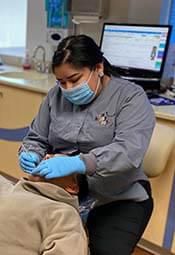Ever have trouble convincing a kid that candy, soda, and other sweet treats really can hurt his or her teeth? Are your warnings about rotten teeth not being taken seriously? There’s a simple and fun experiment you can do to show the effect these things have on tooth enamel over time. It’s a simply tooth decay experiment with eggshells that you can do in your own home.
A Tooth Decay Experiment With Eggshells to Teach Your Kids
This is an easy experiment for kids. The idea is simple: Eggshells are a lot like tooth enamel. And, like tooth enamel, they will get eaten away when they come into contact with acidic beverages.
Here’s what you’ll need for experiment 1 and experiment 2:
- Hard-boiled eggs (at least four, white-shelled eggs)
- Soda (use a brand you prefer) or white vinegar
- A toothbrush and toothpaste
- 3 clear plastic cups
Prepping Your Experiment: Before you start this experiment, ask your child what he or she thinks happens to teeth when they drink soda. Explain to them how their teeth are similar to eggshells, and that this experiment with soda will show them what happens when it’s mixed with the eggs. You can also ask them what other drinks they think could hurt their teeth, and how they can protect their teeth.
Eggshell Experiment 1
- Hard-boil two eggs (avoid cracking the shell; cracked eggs will not work for this experiment) and let them cool.
- Fill one plastic container with soda. Fill another with water. Leave enough room, so they do not overflow.
- Add a single, hard-boiled egg to each cup.
- Cover and let them sit at room temperature for 24 hours. (You might need to change the soda after 12 hours.)
- Take the two eggs out, and observe your initial reactions. (The eggshell in the soda should have started to dissolve, leaving an egg that looks and feels more like a water balloon.) Discuss the changes you see in each egg and ask your child what he or she thinks happened.
If you leave the egg in the soda long enough (a few days), the entire shell will dissolve. Kids often have fun with the egg sac that’s left – it’s like a bouncy water balloon! This helps keep the experiment fun and allows the kids a chance to interact with the eggs.
Eggshell Experiment 2
You can run this as a separate experiment, or do it at the same time with experiment 1. The set-up is the same, except this time, you will need a fluoride gel or fluoride toothpaste.
- Hard-boil two eggs, as in experiment 1, and let them cool.
- Cover both eggs with the fluoride gel or toothpaste. Let this soak in for at least 24 hours.
- After 24 hours, take the eggs out, gently wash off any remaining gel, and place both eggs in their own cups. (Again, one should have soda/vinegar, and one should have water. If you have only one egg, place it in the soda.)
- Cover and let them sit at room temperature for 24 hours, as in experiment 1.
- Again, take the eggs out and observe the differences the soda/vinegar and water did to the eggs, as in experiment 1. What did the fluoride gel or toothpaste do to protect the egg?
What Do We Learn From These Experiments?
This “egg in soda experiment” is an easy experiment for kids to do, and it brings home some facts about tooth decay in a very visual way.
Here are some takeaways that you might discuss with your children:
- Teeth are made from minerals (a crystalline calcium phosphate, if you’re science-inclined). These minerals will begin to dissolve if exposed to acid. Soda is high in acid, as are many fruit juices, tea, etc.
- There is a trade-off between how good a food or drink can be for your health, and what it can do to your teeth. For example, orange juice can help erode teeth, but the vitamins and minerals in orange juice might be worth it (if you also brush well). Soda? Not so much.
- Soda and other drinks can also stain teeth. Did you notice any stains on your eggs after the experiments?
- Fluoride toothpaste helps to protect teeth against tooth decay. This is why it is important to brush with a fluoride toothpaste at least twice a day: It helps to build your protective barrier. You can also get regular fluoride treatments from your dentist for the best protection.
- Wait, what about sugar? Sugar creates a sticky substance, called plaque, which can build on your teeth and become a home for bacteria. And guess what that bacteria does? They produce acids which act directly on your teeth, slowly eating them away.
We hope this tooth decay experiment with eggshells can help your family understand the importance of a healthy oral health routine and diet. You can find more information about plaque, fluoride, dental health, and more throughout our Tooth Wisdom blog. In the meantime, if you do these experiments with your family, tell us about them! We’d love to hear the results.
Improve Your Family’s Oral Health Routine For Brighter, Happier Smiles
Trust your family’s oral health to our team of professionals at MyOrthodontist. As an orthodontic, cosmetic, and family dentistry, we are proud to have some of the best dentists and orthodontists in the country.
When you’re ready to make an appointment, contact us! Our team is happy to work with you to give you, and your family, a healthy, dazzling smile.


